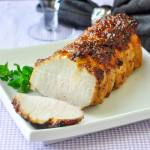
Easy Brown Sugar and Dijon Glazed Pork Loin
Ingredients
- 4 lb centre loin pork roast
- 4 tbsp whole grain Dijon mustard
- 2/3 cup brown sugar
- salt and pepper to season
Instructions
-
Trim the fat from the roast, leaving only a quarter inch of fat on top at the most.
-
Season the pork loin with salt and pepper and open roast the pork on a rack in a 425 degree F oven for 1/2 hour.
-
Brush the entire surface of the roast with a large grain dijon mustard, then press brown sugar into the mustard, all over the roast.
-
Return the roast to the oven, reduce the heat to 375 degrees F. Continue to roast until the internal temperature of the roast hits between 145 to 160 degrees F on a meat thermometer.
-
Baste the roast in the drippings/sauce several times during the cooking time.
-
Let the roast rest for 10 minutes before carving and serving.
Recipe Notes
Cooking time will vary depending upon the size of the roast. Always use a meat thermometer to check that pork is properly cooked. NOTE: This roast was cooked to 160 degrees which is about right for well done. The US Dept of Agriculture revised the safe cooking temperature of pork loin to 145 degrees a couple of years ago but at that temperature the meat will still be a little pink which is perfectly fine but many people will not prefer it pink.
The nutritional information provided is automatically calculated by third party software and is meant as a guideline only. Exact accuracy is not guaranteed. For recipes where all ingredients may not be used entirely, such as those with coatings on meats, or with sauces or dressings for example, calorie & nutritional values per serving will likely be somewhat lower than indicated.